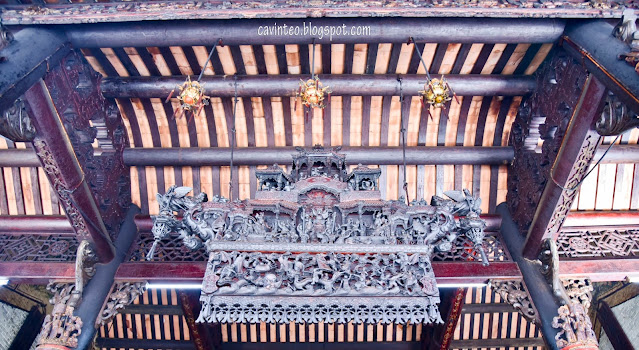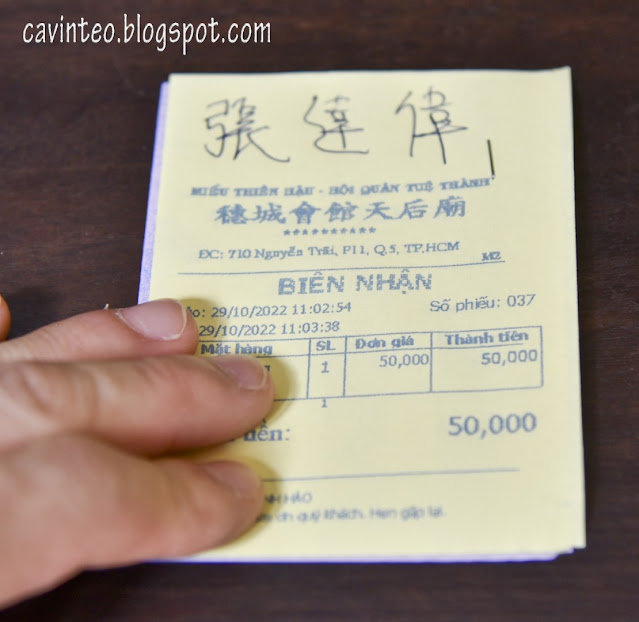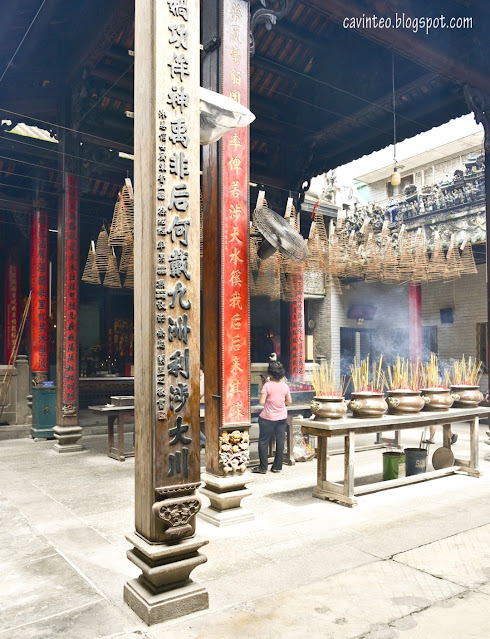Among the three temples we visited on Day Three in Ho Chi Minh City (HCMC), other two being Guān Dì Temple and Ong Bon Temple, this Thien Hau Temple, built in 1760, appeared to be the more popular one.
Front yard which had a simple joss paper burner, and stone lions on both ends. The weird thing was the stone lions as they don't look the same as those we commonly see, with a scarier aura surrounding them.
Temple faced a busy road and interestingly, street vendors offering fortune telling services and mercy release for captivated birds were across the road. I am guessing the pavement alongside the temple was private property.
I am never into mercy release in the above form; it's a business and the way to earn is to catch more birds, which runs contrary to the basis of releasing them in the first place. Faith is a mind boggling thing sometimes.
Intricate designs on the roof reminded me of Singapore's Yueh Hai Ching Temple; albeit rougher, duller although still screaming of so much history. You can find famous legendary characters like those from Journey to the West, the Eight Immortals etc.
Similar to Guān Dì Temple, there was this overhanging structure across the main door. Maybe fellow Singaporeans / Malaysians can let me know if this is the norm for Chinese temples in your area.
Stepping into the first stairwell. In spite of the main door, there was a secondary set of doors that served absolutely no security or any other tangible purpose.
Two deities by the side; don't you just love the exquisite wooden altars that house the models of the deities? God knows how long they have been there.
Wait, another joss paper burner?
Some exhibition in the middle section of the temple; text was in Vietnamese so I didn't bother taking a further look. Unlike Thailand, the tourism in Vietnam is still largely local based as it has a massive population that almost hits 100 million.
Well, the doors looked like they were giving way soon.
Close up look of the intriguing structure that hung over the main temple doors. This was another one though but it's amazing to see the details on the wood carving.
Captivating stretch of fluttering pinkish papers; more on that later.
Main hall for the patron deity of the temple; Mazu! Worshipped by many Chinese in Southeast Asia, Mazu, also known as the sea goddess, was known for providing a safe sea passage for the many migrants who left China for Southeast Asia. Back then, centuries ago, the sea route was the only way; hence contributing to her popularity among our Chinese ancestors.
Actually, it did seem like a doll house.
Mazu, our main lady in the middle. Her companions on the side were the less well know, Lady Dragon Mother and Lady Golden Flower. Frankly, there are just too many deities in Taoism and sometimes, they can take a few identities which is utterly confusing!
Faded wall murals; I am guessing such dilapidated condition would eventually result in some kind of restoration, even though it might be hard to replicate given that the younger generation is no longer as interested with such traditional workmanship.
Stone benches, metal window grilles.
Reminded me of the 80s, when I was still a kid.
Side entrances to two mini shrines; one honoring Guan Yu, the God of War and the other one appeared to be for the God of Fortune although the name used wasn't the conventional one that I was accustomed with.
Smoke from the joss sticks!
First time seeing a fire extinguisher on wheels but given that caretakers for temples are pretty old and that this was a high risk building of significant historical importance; I think it makes sense to have it on wheels!
Offerings you can pay to up your loyal faithfulness to the gods. Everything is tied to money but what about just being a good human being? Be able to help others, be kind, be empathetic etc. Furthermore, such offerings are burnt and that's bad for the environment.
With a row of manned counters, this wouldn't have looked out of place in a bank! Truth is, this is a temple with no side business, that I am aware of, like money lending etc.
It's where money is involved again. You can make your donation here; a direct cash is possible via the money box. Alternatively, you can also choose to have your name written on a pink paper, wall of which I shared earlier, or opt for blessing via the incense coil.
I donated 50,000 dong; just a small sum. While I don't agree to using money as a means to gain favors from gods, I do feel that the temples would still need donation to upkeep their premises. If not, we would see the same that had happened for some temples in Bangkok, like Wat Po and Wat Traimit, where an entrance fee applies.
Process was in place to ensure the money was accountable.
And that the customer was also assured that they are not cheated.
My name on the pink paper; for myself and also family. Sometimes, such blessings comfort us although, especially in difficult times. Last lunar year was a terribly bad year for me and if I can make offerings to make my life better; why not? It's a constant, contradicting battle and the big question mark is "what if".
Can you find mine?! I would check if it is still there the next time I visit. Doubt so though, given the popularity of the temple and aside from Vietnamese and those foreigners of Chinese ethnicity, I saw Japanese, Arabian and English names on the papers!
Video for your viewing pleasure.
And biding goodbye to this beautiful temple. If you only have time for one temple in Chinatown of Ho Chi Minh City (HCMC), I would strongly suggest you go for Thien Hau Temple.
=====
710 Đ. Nguyễn Trãi, Phường 11, Quận 5,
Thành phố Hồ Chí Minh 70000, Vietnam
Map
As above.










































%20-%20Pearl%20of%20the%20Far%20East%20@%20Vietnam%20.JPG)
No comments:
Post a Comment